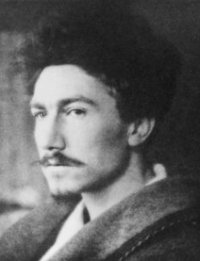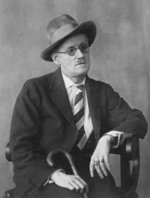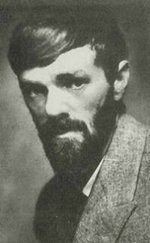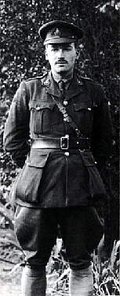Imagism
|
|

Imagism was a movement in early 20th-century Anglo-American poetry that rejected the sentiment and artifice of Romantic and Victorian poetry as well as the contemporary Georgian poets in favour of precision of imagery in clear, sharp language. Group publication of work under the Imagist name in magazines and in four anthologies appearing between 1914 and 1917 featured writing by many of the most significant figures in Modernist poetry in English, as well as a number of other Modernist figures who were to be prominent in fields other than poetry.
Based in London, the Imagists were drawn from Britain, Ireland and the United States and, somewhat unusually for the time, featured a number of women writers amongst their major figures. Historically, Imagism is also significant because it was the first organised Modernist English-language literary movement or group. In the words of T.S. Eliot; "The point de repère usually and conveniently taken as the starting-point of modern poetry is the group denominated 'imagists' (sic) in London about 1910."
Emerging in a period that valued the moralising writings of Longfellow and Tennyson as the paragons for poetry, Imagism called for a return to what were seen as more Classical values, such as directness of presentation and economy of language, as well as a willingness to experiment with non-traditional verse forms. The focus on the "thing" as "thing" (an attempt at isolating a single image to reveal its essence) also mirrors contemporary developments in avant-garde art, especially Cubism, but with the difference that Imagism isolates its object through the use of what Ezra Pound called "luminous details" while Cubism synthesises a single image from multiple perspectives.
| Contents |
Early Imagism
In the first ten years of the 20th century, Alfred Austin was the serving British Poet Laureate. Poetry still had a large audience, and volumes of verse published during the decade included Thomas Hardy's The Dynasts, Christina Rossetti's posthumous Poetical Works, Ernest Dowson's Poems, George Meredith's Last Poems, Robert Service's Ballads of a Cheechako and John Masefield's Ballads and Poems. Future Nobel Prize for literature winner William Butler Yeats was devoting much of his energy to the Abbey Theatre and to on writing for the stage, producing relatively little lyric poetry during this period. In 1907, the Nobel Prize for Literature was awarded to Rudyard Kipling. In general, the poetry of the period was formally traditionalist and decorous in content. These literary figures and values provided the context that Imagists emerged in as a self-consciously avant-garde movement.
The origins of Imagism are to be found in two poems, Autumn and A City Sunset by T. E. Hulme. These were published in January 1909 by the Poets' Club in London in a booklet called For Christmas MDCCCCVIII. Hulme was a student of mathematics and philosophy who had set up the club to discuss his theories of poetry. Writing in A. R. Orage's magazine The New Age, the poet and critic F. S. Flint (a champion of free verse and modern French poetry) was highly critical of the club and its publications. From the ensuing debate, Hulme and Flint became close friends. They started meeting with other poets in an unnamed new group at the Eiffel Tower restaurant in Soho to discuss plans to reform contemporary through free verse and the tanka and haiku and the removal of all unnecessary verbiage from poems. The interest in Japanese verse forms can be placed in a context of the late Victorian and Edwardian revival of interest in Chinoiserie and Japonism as witnessed in the 1890s vogue for William Anderson's Japanese prints donated to the British Museum, performances of Noh plays in London, and the success of Gilbert and Sullivan's operetta The Mikado. Direct literary models were available from a number of sources, including F.V. Dickins’s 1866 Hyak nin is’shiu, or, Stanzas by a Century of Poets, Being Japanese Lyrical Odes, the first English-language version of the Hyakunin isshu, a 13th-century anthology of 100 tanka, the early 20th-century critical writings and poems of Sadakichi Hartmann, and contemporary French-language translations. This group included F.W. Tancred, Joseph Cambell, Edward Storer, Desmond FitzGerald and the writer and actor Florence Farr, who also worked with W.B. Yeats on performances of poetry to a musical accompaniment on the psaltery.
In April 1909, the American poet Ezra Pound was introduced to this group and found that their ideas were close to his own. In particular, Pound's studies of Romance literature had led him to an admiration of the condensed, direct expression that he detected in the writings of Arnaut Daniel, Dante, and Guido Cavalcanti, amongst others. For example, in his 1911/12 series of essays I gather the limbs of Osiris, Pound writes of Daniel's line "pensar de lieis m'es repaus" ("it rests me to think of her") (from the canzone En breu brizara'l temps braus): "You cannot get statement simpler than that, or clearer, or less rhetorical". These criteria of directness, clarity and lack of rhetoric were to be amongst the defining qualities of Imagist poetry. Through his friendship with Laurence Binyon, Pound had already developed an interest in Japanese art and he quickly became absorbed in the study of Japanese verse forms.
In a 1928 letter to the French critic and translator René Taupin, Pound was keen to emphasise another ancestry for Imagism, pointing out that Hulme was, in many ways, indebted to a Symbolist tradition, linking back via W.B. Yeats, Arthur Symons and the '90s generation of British poets to Mallarme. In 1915, Pound edited the poetry of another 90's poet, Lionel Johnson for the publisher Elkin Mathews. In his introduction, he wrote "no one has written purer Imagisme than [Johnson] has, in the line 'Clear lie the fields, and fade into blue air.' It has a beauty like the Chinese."
Early publications and statements of intent
Hdpoet.jpg
In 1911, Pound introduced two other poets to the Eiffel Tower group, his ex-fiancée Hilda Doolittle (who had started signing her work H.D.) and her future husband Richard Aldington. These two were interested in exploring Greek poetic models, especially Sappho, an interest that Pound shared. The compression of expression that they achieved by following the Greek example complemented the proto-Imagist interest in Japanese poetry, and, in 1912, during a meeting with them in the British Museum tea room, Pound told H.D. and Aldington that they were Imagistes, and even appended the signature H.D. Imagiste to some poems they were discussing.
When Harriet Munroe started her Poetry magazine in 1911, she had asked Pound to act as foreign editor. In October 1912, he submitted three poems each by H.D. and Aldington under the Imagiste rubric. That same month, Pound's book Ripostes was published with an appendix called The Complete Poetical Works of T. E. Hulme which carried a note that saw the first appearance of the word Imagiste in print. Aldington's poems, Choricos, To a Greek Marble, and Au Vieux Jadrin, were in the November issue of Poetry and H.D.'s, Hermes of the Ways, Orchard, and Epigram, appeared in the January 1913 issue; Imagism as a movement was launched. The April issue published what was, in the words of J.T. Barbarese, "Imagism's enabling text", Pounds haiku-like "In a Station of the Metro":
- The apparition of these faces in the crowd
- Petals on a wet, black bough.
The March issue of Poetry also contained Pound's A Few Don'ts by an Imagiste and Flint's Imagisme. The latter contained this succinct statement of the group's position:
- Direct treatment of the "thing", whether subjective or objective.
- To use absolutely no word that does not contribute to the presentation.
- As regarding rhythm: to compose in sequence of the musical phrase, not in sequence of the metronome.
Pound's note opened with a definition of an image as that which presents an intellectual and emotional complex in an instant of time. His list of don'ts reinforced Flint's three statements, while warning that they should not be considered as dogma but as the result of long contemplation. Taken together, these two texts comprised the Imagist programme for a return to what they saw as the best poetic practice of the past.
Des Imagistes

Determined to promote the work of the Imagists, and particularly of Aldington and H.D., Pound decided to publish an anthology under the title Des Imagistes. This was published in 1914 by the Poetry Bookshop in London. In addition to ten poems by Aldington, seven by H.D. and six by Pound, the book included work by Flint, Skipwith Cannell, Amy Lowell, William Carlos Williams, James Joyce, Ford Madox Ford, Allen Upward and John Cournos.
Pound's editorial choices were based on what he saw as the degree of sympathy that these writers displayed with Imagist precepts, rather than active participation in a group as such. Williams, who was based in the United States, had not participated in any of the discussions of the Eiffel Tower group. However, he and Pound had long been corresponding on the question of the renewal of poetry along similar lines. Ford was included at least partly because of his strong influence on Pound as the younger poet made the transition from his earlier, Pre-Raphaelite influenced, style towards a harder, more modern way of writing.
The inclusion of a poem by Joyce, I Hear an Army which was sent to Pound by W.B. Yeats, took on a wider importance in the history of literary modernism as the subsequent correspondence between the two led to the serial publication, at Pound's behest, of A Portrait of the Artist as a Young Man in The Egoist. Joyce's poem is not written in free verse, but in rhyming quatrains. However, it does strongly reflect Pound's interest in poems written to be sung to music, such as the troubadours and Cavalcanti.
The book met with little popular or critical success, at least partly because it had no introduction or commentary to explain what the poets were attempting to do, and a number of copies were returned to the publisher.
Some Imagist Poets
The following year, Pound and Flint fell out over their different interpretations of the history and goals of the group arising from an article on the history of Imagism written by Flint and published in The Egoist in May 1915. Flint was at pains to emphasise the contribution of the Eiffel Tower poets, especially Storer. Pound, who believed that the "Hellenic hardness" that he saw as the distinguishing quality of the poems of H.D. and Aldington was likely to be diluted by the "custard" of Storer, was to play no further direct role in the history of the Imagists. He went on to co-found the Vorticists with his friend the painter and writer Wyndham Lewis.

Around this time, the American Imagist Amy Lowell moved to London, determined to promote her own work and that of the other Imagist poets. Lowell was a wealthy heiress from Boston who loved Keats and cigars. She was also an enthusiastic champion of literary experiment who was willing to use her money to publish the group. Lowell was determined to change the method of selection from Pound's autocratic editorial attitude to a more democratic manner. This new editorial policy was stated in the Preface to the first anthology to appear under her leadership: "In this new book we have followed a slightly different arrangement to that of our former Anthology. Instead of an arbitrary selection by an editor, each poet has been permitted to represent himself by the work he considers his best, the only stipulation being that it should not yet have appeared in book form."
The outcome was a series of Imagist anthologies under the title Some Imagist Poets. The first of these appeared in 1915, planned and assembled mainly by H.D. and Aldington. Two further issues, both edited by Lowell, were published in 1916 and 1917. These three volumes featured most of the original poets with the exception of Pound, who had tried to persuade her to drop the Imagist name from her publications and who sardonically dubbed this phase of Imagism "Amy-gism."
Lowell convinced D. H. Lawrence to contribute poems to the 1915 and 1916 volumes, making him the only writer to publish as both a Georgian poet and an Imagist. Marianne Moore also became associated with the group during this period. However, with World War I as a backdrop, the times were not easy for avant-garde literary movements (Aldington, for example, spent much of the war at the front), and the 1917 anthology effectively marked the end of the Imagists as a movement.
The Imagists after Imagism
Imagists.jpg
In 1929, Walter Lowenfels jokingly suggested that Aldington should produce a new Imagist anthology. Aldington, by now a successful novelist, took up the suggestion and enlisted the help of Ford and H.D. The result was the Imagist Anthology 1930, edited by Aldington and including all the contributors to the four earlier anthologies with the exception of Lowell, who had died, Cannell, who had disappeared, and Pound, who declined. The appearance of this anthology initiated a critical discussion of the place of the Imagists in the history of 20th-century poetry.
Of the poets who were published in the various Imagist anthologies, Joyce, Lawrence and Aldington are now primarily remembered and read as novelists. Marianne Moore, who was at most a fringe member of the group, carved out a unique poetic style of her own that retained an Imagist concern with compression of language. William Carlos Williams developed his poetic along distinctly American lines with his variable foot and a diction he claimed was taken from "the mouths of Polish mothers". Both Pound and H.D. turned to writing long poems but retained much of the hard edge to their language as an Imagist legacy. Most of the other members of the group are largely forgotten except inasmuch as they contributed directly to the history of Imagism.
Legacy
Despite being so short-lived as a movement, Imagism was to prove to be deeply influential on the course of modernist poetry in English. This influence can be seen clearly in the work of the Objectivist poets, who came to prominence in the 1930s under the auspices of Pound and Williams. The Objectivists worked mainly in free verse. Clearly linking Objectivism's principles with Imagism's, Zukovsky insisted, in his introduction to the 1931 Objectivist issue of Poetry (Chicago), on writing "which is the detail, not mirage, of seeing, of thinking with the things as they exist, and of directing them along a line of melody."
The influence of Imagism can be seen in a number of 1950s poetic groups and movements, especially the Beat generation, the Black Mountain poets, and others associated with the San Francisco Renaissance. In his seminal 1950 essay, Projectivist Verse, Charles Olson, the theorist of the Black Mountain group, wrote "ONE PERCEPTION MUST IMMEDIATELY AND DIRECTLY LEAD TO A FURTHER PERCEPTION", a credo that derives directly from the Imagists.
Among the Beats, Gary Snyder and Allen Ginsberg in particular were influenced by the Imagist emphasis on Chinese and Japanese poetry. William Carlos Williams was another who had a strong impact on the Beat poets, encouraging poets like Lew Welch and writing an introduction for the book publication of Ginsberg's Howl. One poet associated with the Objectivist group, Louis Zukofsky, was a major influence on the L=A=N=G=U=A=G=E poets, who carried the Imagist focus on formal concerns to a high level of development. Another, Basil Bunting, was a key figure in the early development of the British Poetry Revival, a loose movement that also absorbed the influence of the San Francisco Renaissance poets.
References
- Blau Duplessis, Rachel. H.D. The Career of that Struggle. (The Harvester Press, 1986). ISBN 0-7108-0548-9
- Guest, Barbara. Herself Defined: The Poet H.D. and Her World. (Collins, 1985) ISBN 0385131291
- Jones, Peter (ed.). Imagist Poetry (Penguin, 1972).
- Kenner, Hugh. The Pound Era (Faber and Faber, 1975 edition). ISBN 0-571-10668-4
- Sullivan, J.P. (ed). Ezra Pound (Penguin critical anthologies series, 1970). ISBN 14-080033-6
Online
- Imagists.org (http://www.imagists.org/) Captured April 25th, 2005.
- The 1915 issue of Some Imagist Poets (http://www.geocities.com/~bblair/sip15_title.htm) Captured April 25th, 2005.
- The Objectivist Timeline Project (http://students.washington.edu/dwhunts/objectivism.htm) Captured April 29th, 2005.
- Bibliography of Japan in English-Language Verse (http://themargins.net/bib/B/BK/bk00.html) Captured May 6th, 2005.
- J.T. Barbarese et al: "In a Station of the Metro" at Modern American Poetry (http://www.english.uiuc.edu/maps/poets/m_r/pound/metro.htm) Captured May 9th, 2005.et:Imažism

